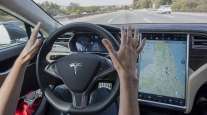Self-Driving Car Pioneers Are Slowing Down After Crashes

A series of high-profile accidents involving self-driving cars is slowing the mad rush into the autonomous-vehicle business, according to a report issued May 2.
The accidents, some of them fatal, have ignited a debate about how to regulate the safety of self-driving vehicles and tempered the public’s expectations, Bloomberg New Energy Finance said in the report. They’ve also exposed the downside of rushing to market, prompting some in the industry to slow down, said Andrew Grant, a London-based analyst at BNEF.
RELATED: Autonomous cars’ shortcomings revealed in California DMV reports
RELATED: Driverless tech companies face scrutiny over safety transparency
Companies including Uber Technologies Inc., Tesla Inc. and Alphabet Inc.’s Google have been touting self-driving cars as the next revolution in transportation. Pressure was mounting to make the technology road-worthy when one of Uber’s cars killed a pedestrian in Arizona in March. The company halted its autonomous-vehicle test program. Toyota Motor Corp. and Aptiv Plc’s Nutonomy then announced they were temporarily suspending public road testing in the United States. Also in March, a driver of a Tesla Model X died in a crash in California that occurred while Autopilot was engaged.
“It gives them breathing room,” Grant said. “Now, they can stop telling investors a growth story. They don’t have to be as aggressive.”
While there have been no significant changes to federal autonomous-vehicle policies in the United States in 2018, Arizona in March ordered Uber to stop operating them on the state’s roads.
Regulators are scrutinizing digital ride-hailing services, too, according to the BNEF report, citing concerns over public infrastructure and their impact on labor markets.
The potential consequences of ride-hailing services such as Uber and Lyft Inc., such as less use of public transportation and more traffic, have prompted several states to propose or pass new taxes. San Francisco and Seattle also are encouraging companies to disclose data on driver earnings and work hours.
“Most of the taxes imposed on ride-hailing services to date have been too small to change consumer behavior,” Grant said in an e-mail. But as cities grapple with the adverse impacts on both traffic and public-transit use, “more taxation could be in the pipeline.”
Other findings from the BNEF report:
• About 20,000 new vehicles were added to fleet-based, car-sharing businesses in the first quarter, boosting the global total to more than 200,000.
• Connected and autonomous-vehicle companies raised almost $400 million in private investment in the first quarter, down 37% from the fourth quarter.
• At the end of April, there were more than 900 million active users of digital hailing apps worldwide and 48 million drivers.





